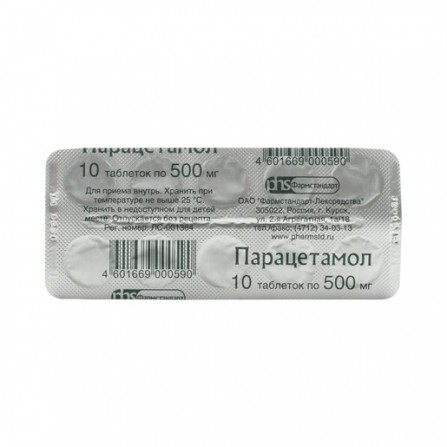Paracetamol-ubf pills 500mg N10
Condition: New product
1000 Items
Rating:
Be the first to write a review!

More info
Active ingredients
Paracetamol
Release form
Pills
Composition
1 tablet contains: paracetamol 500 mg.
Pharmacological effect
Analgesic antipyretic. It has analgesic, antipyretic and weak anti-inflammatory action. The mechanism of action is associated with inhibition of prostaglandin synthesis, a predominant effect on the center of thermoregulation in the hypothalamus.
Pharmacokinetics
After ingestion, paracetamol is rapidly absorbed from the gastrointestinal tract, mainly in the small intestine, mainly by passive transport. After a single dose of 500 mg Cmax in the blood plasma is reached after 10-60 minutes and is about 6 μg / ml, then gradually decreases and after 6 hours it is 11-12 μg / ml. It is widely distributed in the tissues and mainly in liquid media. organism, with the exception of adipose tissue and cerebrospinal fluid. Binding to proteins is less than 10% and slightly increases with overdose. Sulfate and glucuronide metabolites do not bind to plasma proteins even in relatively high concentrations. Paracetamol is metabolized predominantly in the liver by conjugation with the glucuronide, sulfate conjugation and oxidation with the participation of mixed liver oxidases and cytochrome P450. -Benzoquinone imine, which is formed in very small amounts in the liver and kidneys under the influence of mixed oxidases and is usually detoxified by binding to glutathione, can be heated may occur in case of an overdose of paracetamol and cause tissue damage. In adults, most of the paracetamol is associated with glucuronic acid and, to a lesser extent, with sulfuric acid. These conjugated metabolites do not possess biological activity. In premature babies, newborns and in the first year of life, the sulfate metabolite predominates. T1 / 2 is 1–3 hours. In patients with cirrhosis, T1 / 2 is slightly larger. Renal clearance of paracetamol is 5%. It is excreted in the urine mainly in the form of glucuronide and sulfate conjugates. Less than 5% is excreted as unchanged paracetamol.
Indications
Pain syndrome of weak and moderate intensity of various genesis (including headache, migraine, toothache, neuralgia, myalgia, algomenorrhea, pain with injuries, burns).Fever in infectious and inflammatory diseases.
Contraindications
Chronic alcoholism, hypersensitivity to paracetamol.
Use during pregnancy and lactation
Paracetamol penetrates the placental barrier. To date, no negative effects of paracetamol on the fetus in humans have been observed. Paracetamol is excreted in breast milk: the content in milk is 0.04-0.23% of the dose taken by the mother. If you need to use paracetamol during pregnancy and lactation (breastfeeding), you should carefully weigh the expected benefit of therapy for the mother and the potential risk to the fetus or child. In experimental studies, the embryotoxic, teratogenic and mutagenic effects of paracetamol have not been established.
Dosage and administration
Inside or rectally, in adults and adolescents weighing more than 60 kg, they are used in a single dose of 500 mg, up to 4 times a day. The maximum duration of treatment is 5-7 days. Maximum doses: a single dose of 1 g, daily 4 g. For oral administration, 250-500 mg for children aged 6-12 years, 250-500 mg for 1-5 years, 120-250 mg for 1-5 years. , from 3 months to 1 year - 60-120 mg, up to 3 months - 10 mg / kg. Single doses for rectal use in children aged 6-12 years - 250-500 mg, 1-5 years - 125-250 mg. The range of application is 4 times / day with an interval of at least 4 hours. The maximum duration of treatment is 3 days. Maximum dose: 4 single doses per day.
Side effects
On the part of the digestive system: rarely - dyspeptic phenomena, with prolonged use in high doses - hepatotoxic action. From the hematopoietic system: rarely - thrombocytopenia, leukopenia, pancytopenia, neutropenia, agranulocytosis. Allergic reactions: rarely - skin rash, itching, nettle.
Overdose
Symptoms: pallor of the skin, anorexia, nausea, vomiting, hepatonecrosis (the severity of necrosis directly depends on the degree of overdose). Treatment: gastric lavage, activated charcoal.
Interaction with other drugs
With simultaneous use with inducers of liver microsomal enzymes, agents that have a hepatotoxic effect, there is a risk of an increase in the hepatotoxic effect of paracetamol. If used simultaneously with anticoagulants, it is possible that there is little or nomoderately pronounced increase in prothrombin time. With simultaneous use with anticholinergics, paracetamol absorption may be reduced. With simultaneous use with oral contraceptives, paracetamol excretion from the body is accelerated and its analgesic action can be reduced. If used simultaneously with uricosuric agents, their effectiveness is reduced. paracetamol bioavailability is reduced. When used simultaneously with d azepamom may decrease the excretion diazepama.Imeyutsya reports mielodepressivnogo opportunities to strengthen the effect of zidovudine while the use of paracetamol. A case of severe toxic liver damage has been described. Cases of toxic effects of paracetamol with simultaneous use with isoniazid have been described. Concurrent use with carbamazepine, phenytoin, phenobarbital, primidone decreases the effectiveness of paracetamol, which is caused by an increase in its metabolism (glucuronization and oxidation) and elimination from the body. Cases of hepatotoxicity with simultaneous use of paracetamol and phenobarbital are described. When using Kolestiramin for a period of less than 1 hour after taking paracetamol, the absorption of the latter may be reduced. If used simultaneously with lamotrigine, the removal of lamotrigine from the body increases moderately. its concentration in the blood plasma. When used simultaneously with probenecid, paracene clearance may be reduced breakwater; with rifampicin, sulfinpyrazone - it is possible to increase the clearance of paracetamol due to an increase in its metabolism in the liver. When used simultaneously with ethinyl estradiol, the absorption of paracetamol from the intestine increases.
special instructions
It is used with caution in patients with impaired liver and kidney function, with benign hyperbilirubinemia, and also in elderly patients. With long-term use of paracetamol, control of the peripheral blood pattern and liver functional state is necessary. It is used to treat premenstrual tension syndrome in combination with pomabrom (diuretic, xanthine derivative) and mepyramine (a blocker of histamine H1 receptors).



